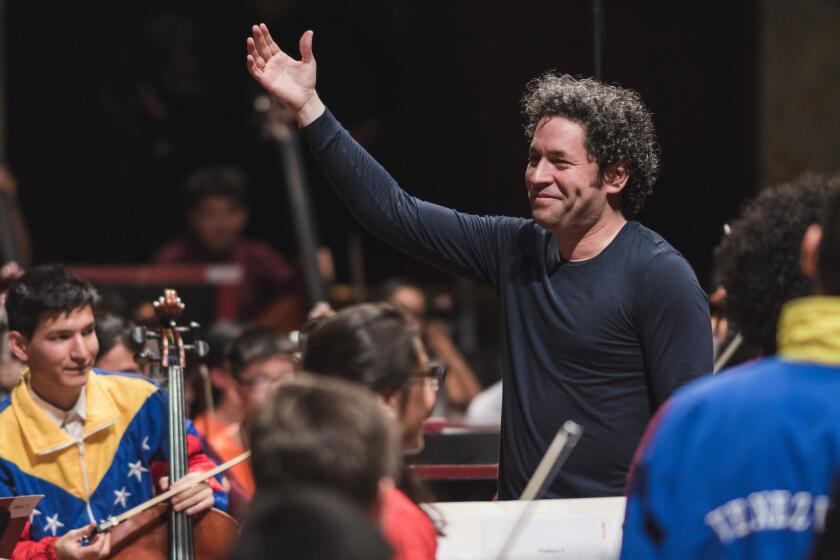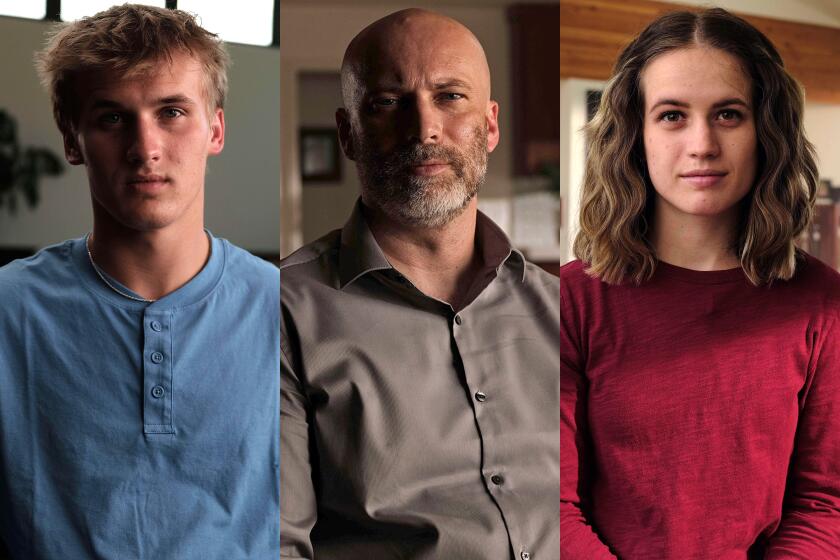There Is Plenty of Order in This Court as Floats Are Judged
- Share via
At 6 a.m. today on the steps of Pasadena’s Tournament House mansion, 10 trumpeters will herald an announcement that officially ends the short but powerful reign of the Rose Parade’s other royal court: the float judges.
For 66 hours, three women -- a renowned parade producer, a furniture showroom designer and a florist to the elite -- will have been immersed in a high-pressure fantasy world to determine which of the parade’s 51 flowered floats eligible for competition captures the Sweepstakes trophy or takes honors for best animation or “best use of roses.”
Millions worldwide will see the winning entries on TV, but what the public didn’t see before the trumpets sounded this morning was judge Jean McFaddin’s reaction to one float Monday morning.
“The creativity, the animation certainly was deserving,” she said. “But the floral part? Just what I don’t want at my funeral!”
Her comments were revealed inside the privacy of the Judge Mobile, a 24-foot Winnebago that shuttled the judges through a down-to-the-second schedule -- five minutes for judging, 30 seconds to move to the next float, 2.5 minutes to hustle back to the Judge Mobile.
The regimen would be repeated 101 times in two days, with a volunteer clicking a digital stop watch and ringing a hand-held school bell to mark the start and finish times during two of three rounds of judging.
At stake was more than civic or corporate pride. The judges’ decisions will make or break float-designers’ careers, sunder dreams or unite an entire city.
The judges serve at the invitation of the Tournament of Roses. McFaddin is a special events producer who is credited with turning the once-sagging Macy’s Thanksgiving Day Parade into a national tradition.
Inside their Judge Mobile refuge, McFaddin and fellow judges Carol Faris Gordy and Delores M. Rosebrock sat around the table en route to the next float-building location -- one of 11 they would visit from Downey to La Canada Flintridge -- speaking in hushed tones.
Their criticisms were sparse, their praise profuse. They were instructed, however, to be discreet and to show little emotion. In private, they admitted they were generally “wowed” and “amazed” and found almost everything downright unbelievable.
Except for one float. All nodded in agreement while traveling west on the Foothill Freeway. Impressive construction. Less-than-impressive flowers.
“They shouldn’t be confining their arrangements to pots,” said Gordy, who is chief executive of Alabama-based Natural Decorations, which counts the White House and Saudi palaces among its clients.
Her company makes artificial flower arrangements, but don’t call them “fake flowers.” It’s the “permanent floral and botanical” industry. And she was invited by tournament President Gary Thomas to be a judge in the 114th Rose Parade because, to do a good fake, you must have intimate knowledge of the real thing.
For Gordy and her fellow judges, the routine was filled with tension, surprises -- “I can’t believe they used apricots to make that octopus” -- and spectators.
“I didn’t think they would let people on the floats decorate when we were judging. It was distracting,” Rosebrock said. She is a woman with an eye for perfection, a furniture showroom designer for professional photographers.
She has created the kind of magazine pictures in Architectural Digest and House Beautiful that the rest of us tear out and save for our dream-kitchen remodelings.
When Rosebrock and her colleagues arrive at a float barn, it’s as if a limousine had pulled up to the red carpet at the Oscars.
“The tournament has a Rose Queen, they have a president and they have a grand marshal,” former judge Scott Acevedo told the judges during their orientation meeting Sunday. “But let me tell you, you are the tournament royalty for the next three days -- more so than anyone else.”
At a float barn in South Pasadena, an advance-team van dubbed the Rocket landed five minutes ahead of the judges, setting off a frenzy.
“The judges are coming! The judges are coming!” shouted Mike McFatridge, construction chairman for the city of South Pasadena entry. “Everyone remember to keep quiet, stay in your place. Absolutely no interaction.”
The Judge Mobile drove up as about 100 silent spectators stood behind barricades. (Thousands of spectators would converge later at another float barn, some cheering with pompoms.)
The bell rang, and the three judges began scoring the city’s “Circus Comes to Town” train float on a scale of 1 to 10. They scored on 14 criteria, from design and concept to color and humor.
Most of the floats Monday were largely unfinished for the first round of judging. The barns were a tangle of scaffolding, floors covered with debris, workers gluing, pasting, snipping. Some floats, like the South Pasadena entry, didn’t have a single flower yet.
Float builders are required to give pitches to the judges, and each speaks with a distinct style.
Tim Estes, president of Fiesta Parade Floats, which has built 13 this year, and his floral designer, Jim Hynds, are the superlative tag team. They pitched “gardeny” floats, “kaleidoscope effects,” a “colorama” of flowers, “confectionery delights.”
Bill Lofthouse, head of Phoenix Decorating Co., the largest float builder, with 25 entries this year, is the cool minimalist. He described his clients -- “Trader Joe’s is a fine specialty food store” -- and then said virtually nothing but “please, enjoy the float.”
After the speeches, the judges made their marks, walking around the floats and scribbling until the bell rang again. A tournament volunteer snatched their score sheets and ran them to the Technology Van, the third and last vehicle in the judge entourage. Three guys immediately input the scores on wireless computers, creating spreadsheets no one but Judge Committee Chairman Myron D. Yanish would be allowed to see.
The South Pasadena folks endured the five-minute judging in silence, but at the final bell burst into applause and cheers, a small-city scene that was repeated in Burbank and La Canada Flintridge.
“Is that not the sweetest thing?” Gordy said. “I feel quivery. The people, how hard they’ve worked, how hard they’ve tried.... They are the most heartwarming.”
If Monday was the preliminary round, Tuesday was Judgment Day. Floats were pulled out of their barns and, at the sound of the ever-present bell, performed for the judges as they if were on the parade route.
Skip Josenhans, the bell ringer, calls it “the five magical minutes.” Christopher Lofthouse of Phoenix Decorating calls it “the pressure cooker.”
Lofthouse had five short minutes to show off a year’s worth of work, hoping to win awards that would bring in more business and keep his career -- well -- afloat. “This is how I make my house and car payment, how I support my family,” he said.
But one glue glob stuck in a transmission, one animated character that failed to move, one skipped verse on a soundtrack would lead to markdowns.
The sponsors and builders thought that Sweepstakes, the top award, would go to either Rain Bird’s “Water Wonderland,” built by Estes, or Trader Joe’s “Island Paradise,” by Lofthouse.
“Well,” McFaddin said, “they may be in for some surprises.”
The judges held their score books close to their chests so no one could see. One year, a float worker was caught with a telephoto lens trying to get a shot of the early scoring.
Craig Bugaski of Festival Artists was nervous Tuesday, standing before his judges. He was about to give the “go” cue for a history-making operation, a fireworks display off the Veterans of Foreign Wars’ freedom float.
“I’m not sure if this is going to work,” he half-apologized to the panel. But after a three-minute medley of patriotic songs, the sparklers erupted. The judges were virtually stone-faced -- until they returned to the Winnebago.
“I need a Kleenex,” said Gordy, so moved by the sight she was dabbing tears. “They put more doobies on it, but overall it’s spectacular,” she added, although it was unclear whether a “doobie” was good or bad.
By the end of the day, the judges had cried several times, and were continuing to mutter “Wow” and “Amazing,” and were waving to more cheering crowds.
They were scheduled for one last look at the floats today -- at 2 a.m. Then it was back to Tournament House for final deliberations.
Hundreds of volunteers and float builders and sponsors would gather on the steps in anticipation of the trumpeted announcement -- except builder Bill Lofthouse.
He planned to be out scanning the crowd’s early reaction to his many creations.
“At the end of the day,” he said, “they are the judges that really count.”
More to Read
The biggest entertainment stories
Get our big stories about Hollywood, film, television, music, arts, culture and more right in your inbox as soon as they publish.
You may occasionally receive promotional content from the Los Angeles Times.










